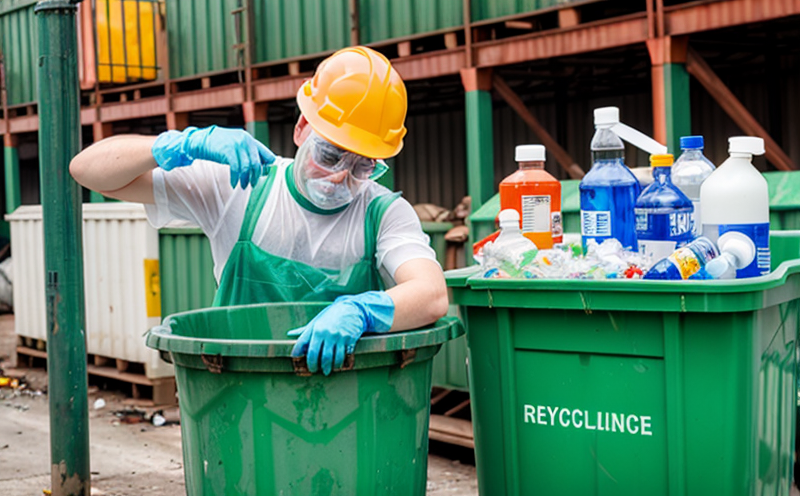DIN 38405 Nitrate and Nitrite Testing in Wastewater
The DIN 38405 standard is a pivotal guideline for the determination of nitrate (NO₃⁻) and nitrite (NO₂⁻) in wastewater. This testing procedure ensures compliance with environmental regulations, especially important for industries that discharge their effluents into public water bodies.
Environmental contamination by nitrates and nitrites can lead to significant ecological harm. High concentrations of these compounds can cause eutrophication, which depletes oxygen levels in aquatic environments, leading to fish kills and the death of other aquatic organisms. Nitrite is particularly dangerous as it can form carcinogenic compounds such as nitrosamines.
DIN 38405 employs colorimetric methods based on spectrophotometric analysis for quantifying nitrate and nitrite in water samples. The testing process involves several critical steps, including the collection of representative wastewater samples, filtration to remove particulates, and subsequent digestion in a strong acid solution. This method ensures accurate measurement by eliminating interfering substances.
The standard specifies precision requirements that are crucial for reliable results. Precision is typically expressed as relative standard deviation (RSD). For nitrate determination, the RSD should be ≤2% at 5 mg/L concentration, and for nitrite, it should be ≤1% at 0.3 mg/L concentration.
The DIN 38405 method is widely used in various sectors such as municipal water treatment plants, chemical manufacturing facilities, and industrial wastewater treatment systems. Compliance with this standard not only protects the environment but also ensures that discharges meet stringent legal requirements set by regulatory bodies like the European Union.
Understanding the implications of nitrate and nitrite contamination is essential for industries involved in waste management and recycling processes. The testing procedure laid down in DIN 38405 plays a crucial role in preventing environmental damage, ensuring public health, and maintaining compliance with international standards like ISO 17025.
| Step | Description |
|---|---|
| 1. Sample Collection | Prompt and representative collection of wastewater samples. |
| 2. Filtration | Filtration to remove particulates and ensure clarity. |
| 3. Digestion in Acid Solution | Digesting the sample with strong acid to release nitrate and nitrite ions. |
| 4. Colorimetric Analysis | Analyzing samples using spectrophotometry for quantification. |
Why It Matters
The importance of DIN 38405 nitrate and nitrite testing cannot be overstated. Compliance with this standard is not just a legal requirement but also an environmental responsibility. By accurately measuring nitrate and nitrite levels in wastewater, industries can prevent harmful environmental impacts.
For quality managers and compliance officers, ensuring that the testing adheres to DIN 38405 helps in maintaining a clean discharge of treated effluents into natural water bodies. This practice is crucial for safeguarding aquatic ecosystems and human health.
R&D engineers involved in wastewater treatment processes can use DIN 38405 as a benchmark to develop and optimize treatment technologies that effectively remove nitrate and nitrite from industrial effluents.
For procurement teams, adherence to this standard ensures that the laboratory testing services they contract are reliable and meet international standards. This consistency is vital for maintaining high-quality environmental practices throughout an organization’s operations.
Scope and Methodology
- Sample Preparation: Collecting representative samples of wastewater, filtering to remove particulates, and digesting in a strong acid solution.
- Colorimetric Analysis: Using spectrophotometric methods for precise determination of nitrate and nitrite concentrations.
- Data Interpretation: Ensuring the results align with the precision requirements specified by DIN 38405, particularly relative standard deviation (RSD).
The method is robust and ensures that the testing process adheres to international standards. This reliability enhances trust in the test outcomes, which are critical for regulatory compliance and environmental protection.
Why Choose This Test
- Accurate quantification of nitrate and nitrite levels in wastewater.
- Compliance with international standards like DIN 38405, ISO 17025, and other relevant environmental regulations.
- Ensures reliable data for regulatory submissions and internal quality control.
- Supports the development of effective wastewater treatment technologies and processes.
- Avoids potential legal issues associated with non-compliance to environmental standards.
- Provides a consistent measurement procedure across different laboratories, enhancing accuracy and reproducibility.





